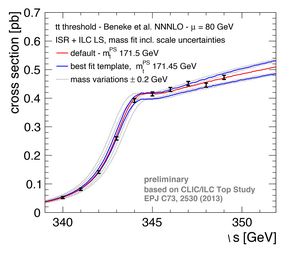Physics at ILC und CLIC
A linear collider enables researchers to carry out a broad experimental program, with a combination of guaranteed measurements in the Higgs, top and precision electroweak sector, and the still speculative possibility of the discovery and the spectroscopy of new physics beyond the Standard Model of particle physics.
A study currently being undertaken by the Group in this context involves investigating the possibilities for the accurate measurement of the mass of the top quark. Better knowledge of this important parameter would be of great significance for a better understanding of the stability of the Standard Model vacuum, among other things. Our results show that a top threshold scan at a linear collider offers the unique opportunity to determine the mass of the top quark with an accuracy of better than 100 megaelectronvolts in a theoretically well understood environment when taking into account theoretical and experimental uncertainties. This accuracy can be achieved at both ILC as well as CLIC.
Image: Simulation of a top threshold scan at ILC to determine the mass of the top quark. This simulation takes into account the theoretical uncertainties of current theoretical computations for the top quark production in electron-positron collisions. [file: Top.pdf]
Furthermore, we investigate the full potential for Higgs physics at CLIC. The possibilities for measuring the branching ratios of the decays into bottom and charm quarks and into gluons, and the ratio of the two production mechanisms via a Z boson and the fusion of two W bosons are investigated in realistic detector simulations. These and other results are used in combined analyses that demonstrate CLIC’s abilities to precisely investigate this newly discovered sector of particle physics.
